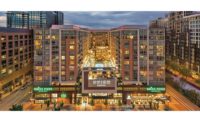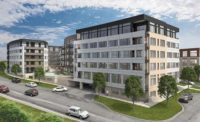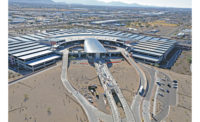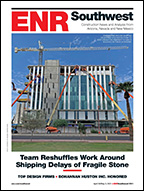However, Weddle says the balanced growth in both private and public sector projects is encouraging to the Southwest markets.
"I'm an optimist in that regard," he says.
In Las Vegas and Phoenix, optimism might be a rising a bit faster than in other areas.
"The Arizona market is really starting to show signs of a resurgence," says Bruce Risley, senior vice president and West region operations director with Highlands Ranch, Colo.-based ARCADIS.
While much of the Arizona activity is new construction, Las Vegas is finding momentum coming from formerly stalled megaprojects that are returning to life. Resorts World Las Vegas is springing from the abandoned Echelon site, and the Sahara Hotel & Casino is being reborn as the SLS Las Vegas.
"It's a very interesting time in Las Vegas. We are currently witnessing several projects that were stalled in the recession now coming back to life, but with refined purpose and focus," says Andy Cohen, co-CEO of Gensler, Las Vegas. "Our clients are cautiously aggressive, spending greater time on due diligence to fully understand the market drivers, Day 2 costs and the experience their developments will create, but then pushing forward in true Las Vegas style with bold new solutions."
Feats of Innovation
The Las Vegas market also boasts feats of engineering, notably the Lake Mead Intake No. 3 project that will allow the metropolitan area to access its share of Colorado River water at lake elevations as low as 1,000 ft above sea level. The intake project includes a 600-ft shaft and a 3-mile-long tunnel. The intake structure is 300 ft below the lake surface. Arup, Las Vegas, and subconsultant Brierley Associates, Littleton, Colo., collaborated with a joint venture of S.A. Healy and Impreglio for owner Southern Nevada Water Authority.
"The structure was built close to the shoreline and then floated out and positioned in the lake bed, thus allowing for the tunnel boring machine to break into and form a seal with the intake structure that connects the tunnel to the lake," says Jon Hurt, principal with Arup.
While much of the Lake Mead project will remain hidden from view, design and engineering that beget structures where people live, work and play in the Southwest have evolved, according to Risley.
This is especially true in regard to sustainability, he says. "We are seeing a lot more emphasis on green design and sustainable infrastructure. It is a trend that is here to stay."
The reason is not just that ecologically concerned structures are hailed by users, but that costs have leveled.
"There is not really as significant of a price premium to be sustainable when it comes to the design of the projects," he says.








Post a comment to this article
Report Abusive Comment